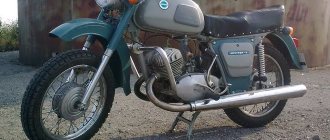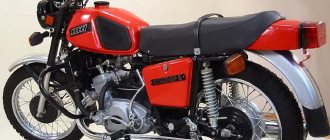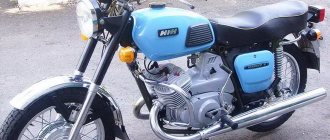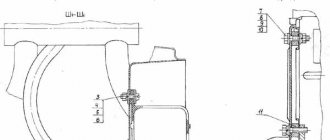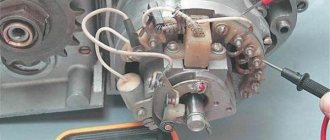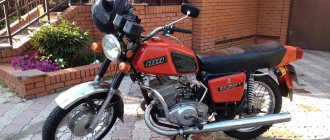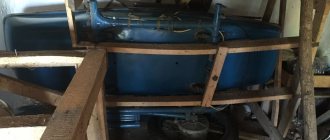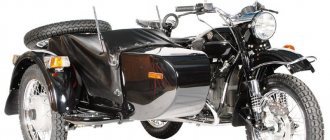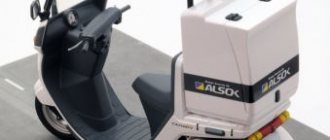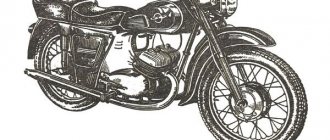In 1980, the Izhevsk Machine-Building Plant launched the IZH Jupiter 4 road motorcycle for mass production. The fourth generation replaced its predecessor IZH Jupiter 3 on the production line and was produced until 1986.
Jupiter 4 could confidently move on roads with any surface, and its key feature was the ability to be used together with a passenger side trailer, which made it possible to transport two passengers at once or use the trailer to transport small loads.
It is the increased passenger capacity that has become an important component of the popularity of motorcycles. In addition, it had the following advantages:
- good dynamic characteristics;
- ease of repair;
- high cross-country ability;
- affordable price;
- high reliability;
- low sensitivity to fuel quality.
The existing disadvantages of IZH Jupiter 4, according to reviews from owners, include:
- poor assembly quality at the factory (connections not tightened, poor contacts, oil leaks);
- violation of synchronization in the operation of the engine cylinders;
- poor wiring diagram;
- frequent overheating of the engine when fully loaded in warm weather.
But due to the corresponding advantages, the motorcycle was most popular among rural residents as a universal vehicle.
Design Jupiter 4
The popularity of the motorcycle among rural residents was due not only to the above advantages, but also to its rather simple design, which consists of the following main components and assemblies:
- Engine. Clutch.
- Transmission.
- Carburetor.
- Two mufflers.
- Generator.
- Frame.
The design features of the motorcycle include the installation of a more powerful engine, the use of special rubber bands for shock absorbers to reduce engine vibration on the frame, and the travel of both wheels was increased to increase cross-country ability. For the first time, a 12-volt electrical circuit was used on IZ Jupiter 4. The optics and light signaling have also been improved.
The simple design of the motorcycle, as well as the traditionally broad unification of all models of the Izhevsk plant, including the IZH Planet 4, which ensured high availability of spare parts, made it possible to carry out repair work in rural conditions.
To increase the service life and reliability of the motorcycle, especially in dusty rural areas, it was necessary to perform timely maintenance. It is for such conditions that the plant has established a fairly small frequency: maintenance No. 1 - every 2000 km, maintenance No. 2 - every 4000 km.
Additional modifications
During production, the car was modified twice. From 1977 to 1980, Izh Jupiter 3 01 was produced, which had a number of differences from the basic version. The model received:
- Possibility of adjusting the gap between the mudguard and the wheel. This was important when operating on country roads.
- Anti-theft lock. In connection with this, the ignition switch circuit has changed.
- Safety bars.
- Standard rear view mirror.
- The rear shock absorbers are of a new design with three positions of stiffness adjustment.
- Changed design of mufflers.
- Rear brake locking, making it easier to install on the parking stop.
There were a number of other minor changes, but they mainly concerned the appearance. As for the performance characteristics, they remained at the same level. From 1979 to 1981, the Izh Jupiter 3 02 was produced, the main difference of which was the fuel tank of a new design and shape.
Improving the IZH motorcycle
Despite the high overall reliability of the motorcycle, the most frequent breakdowns occurred in electrical equipment. First of all, this was due to the 12-volt electrical circuit used on the IZ Jupiter 4, which had not yet been tested and had low reliability, so during repairs even experienced electricians had to use special colored wiring diagrams.
The most common malfunction was loss of connection or oxidation in numerous detachable contacts, which were widely used in the IZ Jupiter 4 wiring. Such connectors are now very widespread in electrical equipment for use in both motorcycles and cars, but then for many motorcycle owners the question was how repair such contacts with your own hands.
Dust, dirt, water and snow, from which a motorcycle is much less protected than a car, were the main causes of malfunction, therefore the main decisions of the owners of IZ Jupiter 4 were aimed at protecting such connections in the wiring diagram.
For this purpose, the contacts were cut off and the wires were soldered together directly, and the contacts were also wrapped very tightly with electrical tape or sealed with plasticine. This made it possible to protect the connections from external harmful influences.
Such solutions did not add beauty to the appearance of the motorcycle, but even without this, many owners sought to make their IZH Jupiter 4 individual and, for this purpose, performed tuning with their own hands. The most common among such works were considered:
- windshield replacement;
- installation of other muffler pipes;
- installation of enlarged wings;
- use of enlarged mirrors;
- changing the shape of turn signals.
Such simple operations made it possible to make a particular motorcycle different from the production version of the fourth generation of Jupiter.
The first material about editorial tests of the IZH-Jupiter-4 motorcycle with a sidecar (“Behind the Wheel,” 1981, No. 11) talked about what distinguishes this model from the previous ones, and about the beginning of the run-in. Now the motorcycle has covered about 7,000 kilometers, and there is an opportunity to evaluate its driving performance and the design of some components.
When the speedometer showed just over 6,000 kilometers and the engine was running perfectly, we began to be bothered by a noise, the source of which was somewhere under the left crankcase cover. The noise is not loud, but quite unpleasant (note that, unfortunately, this sound is well known to many Jupiter fans). The assumption arose that the fault should be looked for in the motor chain drive.
When the crankcase cover was removed at a service station in Zagorsk, the diagnosis was confirmed: the motor transmission chain was very stretched. Willy-nilly, I had to replace it with a new one. This fact, naturally, cannot but upset us, since the mileage of the motorcycle, frankly speaking, is not enough to justify such replacements of parts.
However, our mood was brightened by the quality of the crankcase and its cover with seals. Before disassembly, there were no traces of oil at their junction - no greasy stains familiar to all motorcyclists, no leaks, which gave rise to one of the local wits to joke: “Now you’ll see - there’s no oil there!” But there was exactly enough oil.
It would seem that there is nothing special here, because this is how it should be! Meanwhile, talk to motorcyclists, and you will hear that leaks, sweating, and oil leaks are common, you will see dirty engines, grimy motorcycles. And hence - soiled clothes, damaged shoes... So this is not a small thing, as it might seem. I would like to believe that most IZHs will have such clean, dry engines, and not just the editorial one.
This turn signal light is extremely poorly designed.
There, in Zagorsk, the condition of the rear chain drive was checked. And this chain turned out to be extended. The mechanic who helped us also advised us to replace it. Why did both chains last so little? We do not undertake to answer this question unambiguously. I had a chance to see that many readers justifiably make claims against the motorcycle manufacturer. It is more likely that the bulk of the blame lies with the plant supplying the chains. After all, when replacing a roller chain at a service station, we spent quite a long time looking for one that would completely satisfy us. And they didn’t find it. So I had to agree to install a chain in which individual links in relation to the neighboring ones were as if welded - they were riveted together so “conscientiously”! It is clear that work of this quality does not contribute to increasing the service life of the machine.
A subsequent check of the IZH while driving confirmed that the source of noise in the engine was indeed a stretched motor chain. With the new chain, the motor worked almost the same as at the very beginning of operation.
There were no other serious complaints about the motorcycle, if you don’t remember the notorious turn indicators. They refused, more than once. As a rule, this happened due to a breakdown in contact between the “cartridge” (we put quotation marks on purpose!) of the lamp and the body. The rivets, with the help of which this primitive part is somehow attached to the body, constantly become loose, and each time it was necessary to look for “methods” of restoring contact. When you hold this unfortunate product in your hands, you can’t believe that such an imperfect design could be created by specialists.
That’s how we drive: turning on the sign, we follow it with half an eye. Sometimes it burns, sometimes it doesn’t. But you also need to keep an eye on the road.
***
We like the engine. I like his character, his capabilities, his rhythm. Throughout the entire range of operating speeds, it operates very cleanly, smoothly, smoothly, reminiscent of a turbine when accelerating to high speeds. Vibrations are small; they are almost not felt on the handlebar parts, footpegs, engine levers and saddle. Nothing similar to vibration resonance is revealed; if it exists, it is very weak. Such a result achieved by the Izhevsk team should be welcomed - after all, many motorcycles suffer from increased vibrations, and sometimes even in the most inappropriate speed range.
As far as we can determine, the engine actually develops the power specified by the factory. At the same time, if at low speeds you perceive it as mediocre, then at high speeds you feel the difference. Of course, those who have driven Jupiter 2 will have to relearn a little here: the engine shows its capabilities better at speeds above average. Having felt this, you can start from an intersection, not yielding even to powerful cars for quite a long time.
Knowing how to ride with a raised stroller can come in handy on the road.
We have not yet studied the speed capabilities of a motorcycle with a sidecar. It is unlikely that they are of great interest now: we have very few roads on which motorcyclists are allowed to ride faster than 70 km/h, at the same time, at speeds of 80-90 km/h and above, such a motorcycle consumes fuel with an appetite that would be the envy of others car, and, therefore, such speeds cannot be justified. Due to its innate, organic features, let’s call them that, a motorcycle with a sidecar is a low-speed means of transport.
You can’t compare it with a single motorcycle, much less with a car.
The higher the speed, the greater the proportion of the drag force that is aerodynamic. It depends on the size of the machine (mainly the cross-sectional area) and the perfection of its shape. The latter is characterized by a coefficient that for a motorcycle with a sidecar can be even worse than for a truck - they combine very poorly. What about the cross-sectional area? Just imagine - and you’ll see that it’s about the same as a passenger car. This explains why, with increasing speed, the resistance of such a motorcycle quickly increases, and about 25 hp have to be expended to move at speeds of 90-100 km/h. s., or even more. Of course, fuel consumption is also very high.
When driving in a relaxed style, the 17-liter tank of the new model on conventional flat roads with hard surfaces is enough for about 250 kilometers. Where you often have to use lower gears, especially in the city, fuel consumption may increase.
The engine runs well on the prescribed A-76 gasoline. Several of our test rides on the AI-93 did not reveal any serious arguments in favor of its use.
I would like to say a few words about the transmission, and more specifically, about the gearbox and gear ratios. The latter simply puzzled us in a number of cases, especially when we had to overcome well-known climbs on the roads leading to Tula, Ryazan, Voronezh, and a number of other places. Our motorcycle, if not overloaded, is capable of taking them in direct gear, but at high speeds, providing the necessary reserve of torque. Consequently, this is only possible at speeds above 80-90 km/h. Fulfilling the requirements of traffic rules regarding the speed limit of 70 km/h, you invariably have to drive in third gear on all noticeable inclines, the length of which on many roads is a good half. Of course, such driving is less economical than in fourth. But it is hardly advisable to enhance the car’s performance in fourth gear by simply reducing the teeth of the drive sprocket: lower gears will become too “easy”, and straight driving will be unprofitable on roads where high speeds are allowed. Here, fuel consumption will increase and the engine will overheat.
It seems to be an abnormal situation in which IZHI, JAV, CHZ, and other motorcycles, which are much less adaptable to road conditions than any car with a four-stroke engine, cannot pass most of the climbs in direct gear without exceeding the permitted speed. It is psychologically and physically difficult for a motorbike traveler to “cut” in low gears; it is much easier to take on a multi-kilometer climb on the move, slightly accelerating the car. To a certain extent, this explains speed limit violations by motorcyclists. Meanwhile, the entire development of motorcycle engines in the last 10 years has followed the path of their acceleration, but the design of the gearbox essentially remains the same. So isn't it time to create a five-speed one, in which two higher gears would eliminate the contradictions between the requirements of the Rules and the capabilities of a real motorcycle?
The designs of our motorcycles were developed based on technical conditions that now, as it seems to us, are outdated. There have been big changes in the structure of road traffic, in the Rules, and in its economic indicators that cannot be ignored.
This is not a simple question, but it must be resolved, and the sooner the better. If the driver gets the opportunity to drive on our, not yet the best, roads without tearing up the engine, the number of rule violators will drop sharply, even without the intervention of the traffic police. A lot of fuel and oil will be saved.
From an ergonomic point of view, Jupiter-4 is good! Comfortable steering wheel, modern switches. The tank now has a more beautiful and safe, anatomical shape. The front fork works great. Soft, elastic, it nevertheless never clanged at the end of the stroke. The rear shock absorbers are the same as on the IZH-Planet-Sport, with adjustable stiffness. This is no less important for a motorcycle with a sidecar than for a single person - the behavior of the car greatly depends on the rigidity of the shock absorbers, but here it is easy to change it in the right direction.
Driving any motorcycle with a sidecar is very different from driving a single person, and, among other things, requires a lot of effort. But the Jupiter, when properly adjusted, is very easy to control, although the steering damper has to be tightened to prevent the car from swaying.
Before “Jupiter” we had a chance to travel a lot on “Dnepr-12”, which was already reported in the magazine. In general, the impression is that the beginner is not much inferior to his older brother, except that the behavior of the motorcycle with the driving wheel of the sidecar is, in some cases, certainly more pleasant. During sharp acceleration (and Jupiter-4 is very capable of it!) the stroller noticeably pulls to the right, especially if it is loaded. When turning left, the Jupiter is less agile. It is worse to drive on loose soil, not to mention snow. Here it seems rather weak, despite 28 “forces” in the cylinders: there is not enough power that is much more important - traction. But we must not forget the “other side of the coin”: how much more complex the Dnepr is in design, how much more expensive it is.
As for the road with a good, hard surface or dense dirt, here it is very easy and pleasant to drive the Jupiter. If the driver previously knew only singles, then he will be able to appreciate the curious features and properties of the car with a sidecar only after he has gotten used to it and got used to it. First of all, you need to remember (however, the motorcycle itself will not let you forget it) that when turning right, stability is ensured only at a relatively low speed. Accidentally colliding with a stroller wheel on a hillock, a curb stone, or an obstacle in general can lead to a rollover to the left. You shouldn’t be afraid of this, you just need to be prepared for it, as well as for any difficult situation while driving. If you learn to control the behavior of the motorcycle, there will be no problems. And this is where training in riding with a raised stroller can help. Find a quiet area and try it. It's a simple matter.
***
The electrical equipment of Jupiter-4 is working without any problems so far. The generator is excellent, the battery is always properly charged. Immediately after starting the engine, almost from idle, the red control lamp goes out, indicating that the generator has started operating. The headlight light provides sufficient driving in the dark.
As already mentioned, the direction indicator lights fall out of this orderly row. They need to be redone. In addition, it was confirmed, 1981, No. 11) that the plug connectors in the electrical wiring used on the motorcycle were imperfect. I would like to see them more protected from dust and moisture.
These are the first impressions, the first assessments. Tests are ongoing.
E. Konop, engineer
1982N07P12-13
Technical characteristics of the motorcycle
Despite some shortcomings in the electrical circuit of the motorcycle, its design, advantages and technical characteristics were the main factors in the popularity of the IZH Jupiter 4. Among the key characteristics and parameters, it is necessary to highlight:
- Passenger capacity – 3 people.
- Engine: type – petrol two-stroke,
- fuel – a mixture of gasoline and oil (1/33),
- type of lubricant – mixed,
- cooling method - air,
- number of cylinders – 2,
- volume – 0.35 l,
- power – 28.0 l. With.
- length – 2.17 m,
- type – mechanical,
- weight – 0.17 t (0.26 t),
About the disadvantages
It is worth noting that among owners of IZH motorcycles, the Jupiter IZH-4 model is not very popular. Experienced users claim that the fourth “Jupiter” is the most unsuccessful model from the entire range of IZH motorcycles. In addition to the fact that the strength of the high-speed engine leaves much to be desired, Jupiter-4 has the following “diseases” and disadvantages:
- constant oil leakage from the engine crankcase;
- “ringing” of fingers after short use;
- short gearbox resource;
- constant problems with the ignition system;
- high fuel consumption;
- lack of monitoring systems for fuel level, engine temperature and oil level in the crankcase;
- out-of-date design;
- Lack of knowledge in the field of operation and repair of this motorcycle can lead to significant material costs for repairing the unit and/or treating the biker.
Most owners of Soviet motorcycles are confident in the above. Particular attention must be paid to the ignition system. In fact, the process of setting the ignition timing does not require phenomenal skills or special knowledge.
Reviews
Reviews of “Jupiter IZH-4” have both positive and negative. Some of the bike owners are confident that if you treat your equipment with care and carry out technical inspections and repairs in a timely manner, the results will not take long to arrive. When purchasing a motorcycle, you can have virtually zero knowledge regarding repair and operation. The main thing is that the Jupiter IZH-4 was purchased either in good condition or was completely renovated. Then many problems and “diseases” of the motorcycle will not bother the driver.
Model history
The first prototype, called “Jupiter,” was demonstrated by domestic designers in Brussels (1957) at the annual World Exhibition, and already at the end of the next year preparations for its serial production began.
The model was based on the IZH-56 , but was equipped with an updated 2-cylinder power unit, which was produced at the Izhevsk Mechanical Plant.
During development, the motorcycle was called IZH-58, and only after it was put into production (1961) it received the name “IZH-Jupiter” .
This series was continued in the form of a middle-class model Izh-Jupiter 2, designed for traveling on roads with a wide variety of surfaces.
A modified version was produced from 1965 to 1971.
Compared to its predecessor, the second generation had increased power of the power unit , as well as cast aluminum wheel hubs and pads, which replaced stamped steel counterparts.
Those wishing to purchase an all-terrain vehicle inevitably ask themselves the question: what licenses are needed to operate an ATV? This topic is discussed in detail in our article.
Universal all-season ATV:
Photo gallery
The IZH Jupiter 2 motorcycle is a model known since Soviet times, and many people have their own history associated with this motorcycle. Some people have had it for a long time, while others still only dream of owning it. Owners tune or restore their pets to preserve their original appearance.
Let's take a look at the appearance of some motorcycles that continue to delight their owners today.
Did you like the article? Tell your friends!
